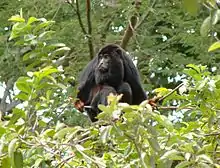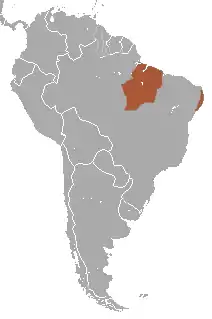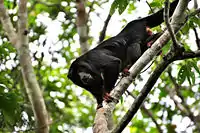Red-handed howler
The red-handed howler (Alouatta belzebul) is a vulnerable species of howler monkey, a type of New World monkey. It is endemic to Brazil, found in the southeastern Amazon and disjunctly in the Atlantic Forest between Rio Grande do Norte and Sergipe.[2]
| Red-handed howler[1] | |
|---|---|
 | |
| Red-handed howler in Amazon, Brazil. | |
| Scientific classification | |
| Domain: | Eukaryota |
| Kingdom: | Animalia |
| Phylum: | Chordata |
| Class: | Mammalia |
| Order: | Primates |
| Suborder: | Haplorhini |
| Infraorder: | Simiiformes |
| Family: | Atelidae |
| Genus: | Alouatta |
| Species: | A. belzebul |
| Binomial name | |
| Alouatta belzebul (Linnaeus, 1766) | |
 | |
| Red-handed howler range | |
| Synonyms | |
|
Simia belzebul Linnaeus, 1766 | |
Taxonomy
Considerable taxonomic confusion has surrounded this species. Until 2001, most authorities included the Amazon black howler as a subspecies (or simply a taxonomically insignificant variation) of the red-handed howler,[3] though its distinction had already been pointed out much earlier.[4] The red-handed howler remained variable in ecology, colour and pattern of the fur, shape of the cranium, and shape of the hyoid bone (of great importance in the voice of the howler monkeys; a likely isolating mechanism between the species),[5] but a geographical pattern was not clear, resulting in it being treated as a monotypic species.[3] In 2006, a major review of the Brazilian members of the genus Alouatta was able to match some of the variations to geography (though further study was recommended), resulting in the recognition of the Spix's red-handed howler and Maranhão red-handed howler as species separate from the red-handed howler.[5] Even with these as separate species, the colour and pattern of the fur of the red-handed howler remains variable. Most adults are black with reddish-brown hands, feet and distal part of their tails, but some are entirely black (resembling the Amazon black howler), reddish (resembling the red howlers) or somewhere in between.[5]
Distribution and life history
It lives in the biomes of Amazonian and Atlantic forests which consist of dense forest separated by drier areas. These animals can live up to 20 years,[6] and do not mature until later in their lives. They have a long gestation period, and generally reproduce more slowly than similar-sized mammals of other species.[7] From the births that have been recorded, red-handed howlers have quick, quiet births during the day when they are normally active. Once born, if the mother is experienced, she will carry her young ventrally for three weeks and then switch to dorsally once the offspring is slightly more developed.[8]
Behavior and diet
When not foraging, red-handed howlers rest in the canopy of mature trees 20 m (66 ft) from the forest floor.[8] They also live in social groups of seven to 12 members, with one or two mature males, females, juveniles, and infants.[9]
Threats

Threats to this species are numerous. First, they are a large-bodied mammal hunted for food. Females with young are especially good targets for hunting because the babies can be sold as pets and the mothers can be used for their meat. Slower reproduction of these mammals also prevents them from replenishing the population in response to this pressure. The red-handed howler monkey has one of the smallest ranges of their genus, which makes them even more susceptible to threats. Second, the Trans-Amazonia and the Belém–Brasília Highways intersect their habitats, which causes collisions with automobiles. Third, the threat from agriculture is increasing. Increasing population pressures have forced farmers to clear more land for farming and these clear-cut methods are too much of a disturbance for the red-handed howler. Some small disturbances are tolerated by species that focus more on leaves, but since A. belzebul is mostly frugivorous, it is harder for them to adapt to change. Logging is yet another concern, because it not only disrupts the habitat too much, but it also allows better access to their habitats for hunters by use of the access roads. Fourth, habitat fragmentation accompanies all of these disturbances. If the forest does eventually regenerate, there will still be no way for new howlers to come back into the area and it also prohibits gene flow and the amount of genetic variation will decrease.[7] Lastly, predation can have a large effect on the population. Since the populations are usually in groups in small areas, they are easy prey for animals such tayras. One study found tayras had found their way onto an island and took out a large portion of the population by hunting together and preying on the family groups in the area.[9]
Conservation steps
A variety of options can be put into place to help the red-handed howler monkey recover. First, landowners can be encouraged to make sanctuaries or protect vital habitats. Since this species relies so heavily on fruit, certain habitats with a variety of fruit-producing tree stands should be focused on for protection. Second, if slash-and-burn methods are needed, farmers could use smaller portions of forest and rotate often to allow for forest regeneration and repopulation by howlers. Corridors could also be maintained between properties, crop areas, and developed areas. Success has also been documented on the use of ladder bridges across roads to allow red-handed howlers to cross roads safely. Third, translocation is could be used to repopulate suitable habitat the animals may not be able to reach because of fragmentation. Translocation could also be a useful tool in allowing gene flow between populations that would generally not mix.[7] Lastly, the genetics of the populations should be monitored to make sure adequate genetic variability is present to sustain the populations. Some of these studies are already being done using microsatellite loci to determine diversity.[10][11]
References
- Groves, C. P. (2005). Wilson, D. E.; Reeder, D. M. (eds.). Mammal Species of the World: A Taxonomic and Geographic Reference (3rd ed.). Baltimore: Johns Hopkins University Press. p. 148. ISBN 0-801-88221-4. OCLC 62265494.
- Valença-Montenegro, M. M.; Fialho, M.S.; Carvalho, A. S.; Ravetta, A. L.; Régis, T.; de Melo, F. R.; Jerusalinsky, L.; Veiga, L. M.; Mittermeier, R. A.; Cortes-Ortíz, L.; Talebi, M. (2021). "Alouatta belzebul". IUCN Red List of Threatened Species. 2021: e.T39957A190412426. doi:10.2305/IUCN.UK.2021-1.RLTS.T39957A190412426.en. Retrieved 19 November 2021.
- Groves, C. (2001). Primate Taxonomy. Smithsonian Institution Press. ISBN 1-56098-872-X
- da Cruz Lima, E. (1945). Mammals of Amazônia. Vol. 1. Contribuições do Museu Paraense Emílio Goeldi de História Natural e Etnografia.
- Gregorin, R. (2006). (in Portuguese) Taxonomia e variação geográfica das espécies do gênero Alouatta Lacépède (Primates, Atelidae) no Brasil. Rev. Bras. Zool. 23(1).
- Nascimento F. F., Bonvicino C. R., De Oliverira M. M., Schneider M. P. C. (2008). Population Genetic Studies of Alouatta Belzebul from the Amazonian and Atlantic Forests. American Journal of Primatology 70, 423-431.
- Horwich R. H. (1998). Effective Solutions for Howler Conservation. International Journal of Primatology 19,3.
- Camargo C. C., Ferrari S. F. (2007). "Observations of Daytime Births in Two Groups of Red-Handed Howlers (Alouatta belzebul) on an Island in the Tucurui Reservoir in Eastern Brazilian Amazonia". American Journal of Primatology 69, 1075-1079.
- Camargo C.C., Ferrari S.F. (2007). Interactions between tayras (Eira barbara) and red-handed howlers (A. belzebul) in eastern Amazonia. Primates 48(2):147-50
- Goncalves E. C., Silva A., Barbosa M. S. R., Schneider M. P. C. (2004). Isolation and characterization of microsatellite loci in Amazonian red-handed howlers Alouatta belzebul (Primates, Plathyrrini). Molecular Ecology Notes 4, 406-408.
- Bastos, H. B.; Gonçalves, E. C.; Ferrari, S. F.; Silva, A.; Schneider, M. P. C. (2010). "Genetic structure of red-handed howler monkey populations in the fragmented landscape of Eastern Brazilian Amazonia". Genetics and Molecular Biology. 33 (4): 774–780. doi:10.1590/S1415-47572010000400027. PMC 3036160. PMID 21637590.
